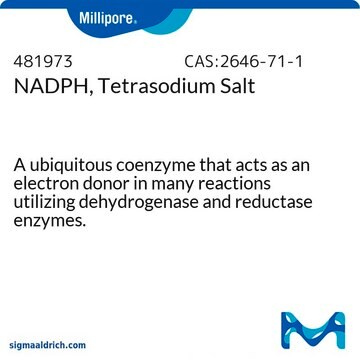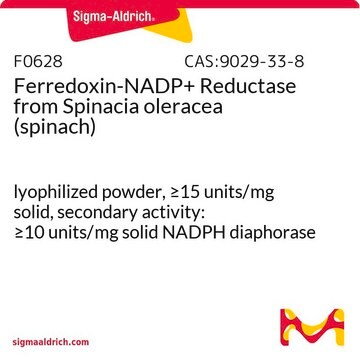No, this product does not contain FAD and is not FAD-dependent. This product is Glucose 1-Dehydrogenase, as such this is an NAD dehydrogenase.
Kluczowe dokumenty
19359
Glucose dehydrogenase from Pseudomonas sp.
powder, white, ≥200 U/mg
Synonim(y):
GDH
Wybierz wielkość
1170,00 zł
Wybierz wielkość
About This Item
1170,00 zł
Polecane produkty
pochodzenie biologiczne
bacterial (Pseudomonas spp.)
Formularz
powder
aktywność właściwa
≥200 U/mg
charakterystyka ekologicznej alternatywy
Waste Prevention
Design for Energy Efficiency
Learn more about the Principles of Green Chemistry.
sustainability
Greener Alternative Product
kolor
white
kategoria ekologicznej alternatywy
, Enabling
temp. przechowywania
−20°C
Powiązane kategorie
Opis ogólny
Zastosowanie
Działania biochem./fizjol.
Definicja jednostki
Kod klasy składowania
11 - Combustible Solids
Klasa zagrożenia wodnego (WGK)
WGK 3
Temperatura zapłonu (°F)
Not applicable
Temperatura zapłonu (°C)
Not applicable
Środki ochrony indywidualnej
Eyeshields, Gloves, type N95 (US)
Wybierz jedną z najnowszych wersji:
Masz już ten produkt?
Dokumenty związane z niedawno zakupionymi produktami zostały zamieszczone w Bibliotece dokumentów.
-
Does this GDH contain FAD?
1 answer-
Helpful?
-
-
Does this product contain co-factor NADH?
1 answer-
NADH is already present as a cofactor in this product, so there is no need to add it.
Helpful?
-
-
What solvent can Product 19359, Glucose dehydrogenase be dissolved in? How should it be stored?
1 answer-
Glucose Dehydrogenase can be dissolved in a solvent such as a phosphate buffer or Tris-HCl buffer. The product must be stored in a cool, dry and well-ventilated place with the container tightly closed. Recommended Storage temperature is -20°C.
Helpful?
-
Active Filters
Nasz zespół naukowców ma doświadczenie we wszystkich obszarach badań, w tym w naukach przyrodniczych, materiałoznawstwie, syntezie chemicznej, chromatografii, analityce i wielu innych dziedzinach.
Skontaktuj się z zespołem ds. pomocy technicznej








